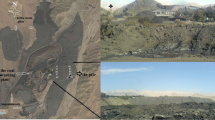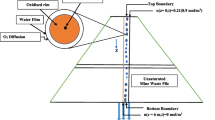Abstract
A one-dimensional numerical finite volume model is presented to simulate pyrite oxidation and reactive transportation of the oxidation products in a pyritic, carbonate-rich, coal waste pile. The proposed model incorporates the shrinking core concept for describing pyrite oxidation, pyrite surface area reduction, oxygen diffusion, and transport of the oxidation products through the waste pile. The model governing equations were solved using the PHOENICS computational fluid dynamics model. The accuracy of the model was verified with field data. Pyrite oxidation was more intense at shallower depths where oxygen decreased almost linearly from the pile surface to an approximate depth of 2 m. The lowest pH, 3.5, was predicted at a depth of 0.5 m. The waste pile has high neutralisation potential due to buffering by carbonate minerals. The maximum concentration of SO4 2−, 31.6 mol/m3, was predicted at an approximate depth of 4 m and to remain constant throughout the rest of waste profile. Simulation of a scenario with a cap shows that iron and sulphate was removed from the upper parts of the pile; their peak concentrations shifted downward due to dilution. Oxygen source removal limited iron and sulphate production. These results will be useful for developing an appropriate remediation scheme.
Zusammenfassung
Ein ein-dimensionales, numerisches Modell (finite Volumen) wird vorgelegt, das der Simulation von Pyritoxydation und des reaktiven Transportes der Oxydationsprodukte in einer pyritischen und karbonatreichen Kohlenbergedeponie dient. Zur Beschreibung der Pyritoxydation berücksichtigt das vorgeschlagene Modell das Konzept eines schwindenden Kernes und abnehmender Pyritoberflächen, sowie von Sauerstoffdiffusion und Transport der Oxydationsprodukte durch den Bergehaufen. Die Gleichungen, welche das Modell beschreiben, wurden mit Hilfe der PHOENICS Fluiddynamik gelöst. Die Genauigkeit des Modelles wurde mittels Geländedaten verifiziert. In geringer Tiefe, in der die Sauerstoffkonzentration von der Oberfläche der Bergedeponie bis ca. 2 m Tiefe abnahm, war die Pyritoxydation stärker. Der minimale pH-Wert, 3,5, wurde für eine Tiefe von 0,5 m vorausgesagt. Wegen hoher Pufferung durch Karbonatminerale hat die Bergedeponie ein hohes Neutralisationspotential. Die maximale SO42- Konzentration, 31.6 mol/m3, wurde für eine Tiefe von etwa 4 m vorausgesagt. Diese Größenordnung findet sich im gesamten Rest der Deponie. Die Simulation eines Scenarios mit einer Deckschicht ergibt den Befund, daß Eisen und Sulphat aus dem gesamten höheren Teil der Deponie verlagert wurden; höchste Konzentrationen wurden auf Grund von Verdünnung nach unten verlagert. Eine Entfernung der Sauerstoffquelle begrenzte Eisen- und Sulfatproduktion. Die Ergebnisse werden für die Entwicklung eines angepaßten Sanierungsschemas nützlich sein.
Resumen
Se presenta un modelo numérico unidimensional de volumen finito para simular la oxidación de pirita y el transporte de los productos de oxidación en una pila de residuos de carbón ricos en carbonato. El modelo propuesto incorpora el concepto de `shrinking core′ para describir la oxidación de pirita, la reducción del área superficial de la pirita, la difusión de oxígeno y el transporte de los productos de oxidación a través del residuo de la pila. Las ecuaciones del modelo fueron resueltas utilizando el modelo computacional de fluido dinámico PHOENICS. La precisión del modelo fue verificada con datos de campo. La oxidación de pirita fue más intensa a menores profundidades donde el oxígeno decrecía casi linealmente desde la superficie de la pila hasta una profundidad aproximada de 2 m. El menor pH, 3,5, fue predicho para una profundidad de 0,5 m. La pila de residuos tiene un alto potencial neutralizante debido al efecto amortiguador de los carbonatos. La concentración máxima de sulfatos, 31,6 mol/m3, fue predicha a una profundidad aproximada de 4 m que permanecería constante en el resto de la pila. La simulación de una situación con una tapa, muestra que hierro y sulfato fueron removidos desde las partes superiores de la pila; sus concentraciones pico bajaron debido a la dilución. La remoción de la fuente de oxígeno limitó la producción de hierro y sulfato. Estos resultados serán útiles para desarrollar un esquema apropiado de remediación.
抽象
本文提出一种一维有限体积数值模型,模拟含硫化物-富碳酸盐煤矿矸石堆中黄铁矿的氧化及氧化产物的反应运移过程。该模型结合了缩芯概念模型,描述整个矸石堆内的黄铁矿氧化、黄铁矿表面缩小、氧气扩散和氧化产物运移特征。运用PHOENICS流体动力学模型求解本模型的控制方程。利用现场试验数据验证模型精度。从矸石堆表面至大约2 m深范围内,氧含量线性减少,黄铁矿在矸石堆浅表氧化强烈。预测pH最低值(3.5)将出现在矸石堆内0.5 m深处。因为所含碳酸盐矿物的缓冲作用,矸石堆具有较强的中和潜力。自矸石堆表面至埋深4处,硫酸盐(SO42-)浓度将达至最大(31.6 mol/m3) 并保持稳定。在矸石堆加盖的情形下,模拟结果显示:矸石堆浅部铁和硫酸盐被去除;它们的峰值浓度向下转移。氧源的去除抑制了铁和硫酸盐产生。研究对矸石堆治理方案制定具有重要意义。










Similar content being viewed by others
References
Agah A, Doulati Ardejani F, Ghoreishi H (2013) Two-dimensional numerical finite volume modeling of processes controlling distribution and natural attenuation of BTX in the saturated zone of a simulated semi-confined aquifer. Arab J Geosci 6(6):1933–1944
Atkins AS, Pooley FD (1982) The effects of bio-mechanisms on acidic mine drainage in coal mining. Int J Mine Water 1:31–44
Bain JG, Blowes DW, Robertson WD, Frind EO (2000) Modelling of sulfide oxidation with reactive transport at a mine drainage site. J Contam Hydrol 41:23–47
Blowes DW, Ptacek CJ, Frind EO, Johnson RH, Robertson WD, Molson JW (1994) Acid neutralization reactions in inactive mine tailings impoundments and their effect on the transport of dissolved metals. In: Proceedings, 3rd international conference on the abatement of acidic drainage, Pittsburgh, pp 429–438
Cathles LM, Apps JA (1975) A model of the dump leaching process that incorporates oxygen balance, heat balance and air convection. Metall Trans B 6B:617–624
Davis GB, Ritchie AIM (1986) A model of oxidation in pyritic mine wastes: part 1: equations and approximate solution. Appl Math Model 10(5):314–322
Davis GB, Doherty G, Ritchie AIM (1986) A model of oxidation in pyritic mine wastes: part 2: comparison of numerical and approximate solutions. Appl Math Model 10(5):323–329
Doulati Ardejani F (2003) Hydrogeological investigation of backfilled surface coal mine sites, PhD Thesis, Univ of Wollongong, NSW, Australia, February 2003, p 435
Doulati Ardejani F, Singh RN, Baafi EY (2004a) Use of PHOENICS for solving one dimensional mine pollution problems. PHOENICS J: Comput Fluid Dyn Appl 16:23 (on CD)
Doulati Ardejani F, Singh RN, Baafi EY (2004b) Numerical modelling of ion-exchanging solute transport in groundwater systems. PHOENICS J: Comput Fluid Dyn Appl 16:18 (on CD)
Doulati Ardejani F, Jodieri Shokri BJ, Moradzadeh A, Soleimani E, Ansari Jafari M (2008) A combined mathematical-geophysical model for prediction of pyrite oxidation and pollutant leaching associated with a coal washing waste dump. Int J Environ Sci Technol 5(4):517–526
Doulati Ardejani F, Jodieri Shokri B, Bagheri M, Soleimani E (2010) Investigation of pyrite oxidation and acid mine drainage characterization associated with Razi active coal mine and coal washing waste dumps in the Azad Shahr-Ramian region, northeast Iran. Environ Earth Sci 61:1547–1560
Doulati Ardejani F, Badii Kh, Farhadi F, Aziz Saberi M, Jodeiri Shokri B (2012) A computational fluid dynamic model for prediction of organic dyes adsorption from aqueous solutions. Environ Model Assess 17:505–513
Elberling B, Nicholson RV, Scharer JM (1994) A combined kinetic and diffusion model for pyrite oxidation in tailings: a change in controls with time. J Hydrol 157(1):47–60
Gerke HH, Molson JW, Frind EO (2001) Modelling the impact of physical and chemical heterogeneity on solute leaching in pyritic overburden mine spoils. Ecol Eng 17:91–101
Gladfelter WL, Dickerhoof DW (1976) Use of atomic absorption spectrometry for iron determinations in coals. Fuel 55(4):360–361
Jaynes DB, Rogowski AS, Pionke HB (1984a) Acid mine drainage from reclaimed coal strip mines 1. Model description. Water Resour Res 20(2):233–242
Jaynes DB, Rogowski AS, Pionke HB (1984b) Acid mine drainage from reclaimed coal strip mines 2. Simulation results of model. Water Resour Res 20(2):243–250
Lefebvre R (1994) Caracterisation et modelisation numerique du drainage minier acide dans les haldes de steriles (Characterization and numerical simulation of acid mine drainage in waste rocks), PhD Thesis, Univ Laval, Quebec City, Canada (in French)
Lefebvre R, Gelinas PJ (1995) Numerical modelling of AMD production in waste rock dumps. In: Proceedings, conference on mining and the environment, Sudbury, pp 869–878
Lefebvre R, Hockley D, Smolensky J, Lamontagne A (2001) Multiphase transfer processes in a waste rock piles producing acid mine drainage: 2. Applications of numerical simulation. J Contam Hydrol 52:165–186
Levenspiel O (1972) Chemical reaction engineering. John Wiley, New York, p 578
Mayer KU, Frind EO, Blowes DW (2002) Multicomponent reactive transport modeling in variably saturated porous media using a generalized formulation for kinetically controlled reactions. Water Resour Res 38(9):1–21
Molson JW, Fala O, Aubertin M, Bussière B (2005) Numerical simulations of pyrite oxidation and acid mine drainage in unsaturated waste rock piles. J Contam Hydrol 78:343–371
Moncur MC, Jambor JL, Ptacek CJ, Blowes DW (2009) Mine drainage from the weathering of sulphide minerals and magnetite. Appl Geochem 24:2362–2373
Pantelis G, Ritchie AIM (1991) Macroscopic transport mechanisms as rate-limiting factor in dump leaching of pyritic ores. Appl Math Model 15:136–143
Pantelis G, Ritchie AIM (1992) Rate-limiting factors in dump leaching of pyritic ores. Appl Math Model 16:553–560
Qiang X, Bing L, Hui-yun W, Lei L (2006) Numerical simulation of trace element transport on subsurface environment pollution in coal mine spoil. J Trace Elem Med Bio 20:97–104
Reddi LN, Inyang HI (2000) Geoenvironmental engineering, principles and applications. Marcel Dekker, New York, p 494
Rogowski AS, Pionke HB, Broyan JG (1977) Modelling the impact of strip mining and reclamation processes on quality and quantity of water in mined areas: a review. J Environ Qual 6(3):237–244
Rubin J, James RV (1973) Dispersion-affected transport of reacting solutes in saturated porous media: Galerkin method applied to equilibrium-controlled exchange in unidirectional steady water flow. Water Resour Res 9(5):1332–1356
Seifpanahi Shabani K, Doulati Ardejani F, Singh RN, Marandi R, Soleimanyfar H (2011) Numerical Modeling of Cu2+ and Mn2+ ions biosorption by Aspergillus Niger fungal biomass in a continuous reactor. Arch Min Sci 56(3):461–476
Shahhoseiny M, Doulati Ardejani F, Shafaei SZ, Noaparast M, Hamidi D (2012) Geochemical and Mineralogical Characterization of a Pyritic Waste Pile at the Anjir Tangeh Coal Washing Plant, Zirab, Northern Iran. Mine Water Environ 32(2):84–96
Shahhosseini M, Doulati Ardejani F, Shafaei SZ (2013) Geochemistry and quality assessment of surface water in an active coal washing plant of northern Iran. Environ Eng Manag J (in press)
Singer PC, Stumm W (1970) Acidic mine drainage: the rate determining step. Science 167:1121–1123
Singh RN, Doulati Ardejani F (2004) Finite volume discretisation for solving acid mine drainage problems. Arch Min Sci 49(4):531–556
Spalding DB (1981) A general purpose computer program for multi-dimensional one- and two-phase flow. Math Comput Simul 23(3):267–276
Walter AL, Frind EO, Blowes DW, Ptacek CJ, Molson JW (1994) Modelling of multicomponent reactive transport in groundwater, 1: Model development and evaluation. Water Resour Res 30(11):3137–3148
Wunderly MD, Blowes DW, Frind EO, Ptacek CJ (1996) Sulfide mineral oxidation and subsequent reactive transport of oxidation products in mine tailings impoundments: a numerical model. Water Resour Res 32(10):3173–3187
Acknowledgments
The authors acknowledge, with sincere appreciation, the financial support of the Islamic Azad University, Langaroud Branch. Many thanks are due to the Alborz Markazi coal company for supporting this research and to Shahrood University of Technology for providing PHOENICS software.
Author information
Authors and Affiliations
Corresponding author
Electronic supplementary material
Below is the link to the electronic supplementary material.
10230_2014_275_MOESM1_ESM.pdf
Comparison of the numerical modelling predictions (lines) with analytical solution results (dots) for oxygen concentration versus depth over 1-year period for different effective diffusion coefficients (Modified from Doulati Ardejani et al. 2010) (PDF 390 kb)
10230_2014_275_MOESM2_ESM.pdf
Model predictions for oxygen mole fraction versus depth over 22-year period for different diffusion coefficients (PDF 388 kb)
10230_2014_275_MOESM3_ESM.pdf
Pyrite content remaining in the waste particles versus depth over a 22 year period based on different effective diffusion coefficients of oxygen transport model (PDF 388 kb)
10230_2014_275_MOESM4_ESM.pdf
Sulphate concentration versus depth over a 22 year period based on different effective diffusion coefficients of oxygen transport model (PDF 387 kb)
Rights and permissions
About this article
Cite this article
Doulati Ardejani, F., Jannesar Malakooti, S., Ziaedin Shafaei, S. et al. A Numerical Multi-Component Reactive Model for Pyrite Oxidation and Pollutant Transportation in a Pyritic, Carbonate-Rich Coal Waste Pile in Northern Iran. Mine Water Environ 33, 121–132 (2014). https://doi.org/10.1007/s10230-014-0275-7
Received:
Accepted:
Published:
Issue Date:
DOI: https://doi.org/10.1007/s10230-014-0275-7




